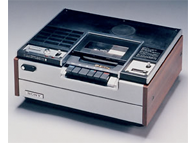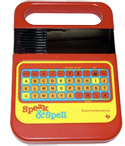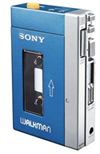The Single Greatest Year in Tech History, Part One: The 1970s
We're going to identify the one year that made the biggest difference...and we need your help to do the job.By Harry McCracken | Monday, December 1, 2008 at 11:34 am
1975
 This was the year that a Boston-area geek finally convinced his equally geeky buddy to drop out of Harvard so they could found a company together. The geeks? Paul Allen and Bill Gates. The company? The quaintly hyphenated Micro-Soft, whose initial product was a version of the BASIC programming language for the Altair. Not too far from Boston, in Peterborough, New Hampshire, BYTE magazine was founded. (It was the most successful computer mag of its era, and a lot of people still get wistful when they think about it.) Over on the other coast, in Silicon Valley, Gordon French and Fred Moore founded the influential Homebrew Computer Club; among other things, Apple Computer was more or less a spinoff of the club’s meetings. 1975 was also the year that the VCR entered the living room, in the form of Sony’s Betamax. (Yes, Beta was cool before it wound up as a synonym for “ill-fated technical standard.”) And IBM introduced the Model 3800, the first laser printer to be commercially available.
This was the year that a Boston-area geek finally convinced his equally geeky buddy to drop out of Harvard so they could found a company together. The geeks? Paul Allen and Bill Gates. The company? The quaintly hyphenated Micro-Soft, whose initial product was a version of the BASIC programming language for the Altair. Not too far from Boston, in Peterborough, New Hampshire, BYTE magazine was founded. (It was the most successful computer mag of its era, and a lot of people still get wistful when they think about it.) Over on the other coast, in Silicon Valley, Gordon French and Fred Moore founded the influential Homebrew Computer Club; among other things, Apple Computer was more or less a spinoff of the club’s meetings. 1975 was also the year that the VCR entered the living room, in the form of Sony’s Betamax. (Yes, Beta was cool before it wound up as a synonym for “ill-fated technical standard.”) And IBM introduced the Model 3800, the first laser printer to be commercially available.
1976
 Zilog’s Z80 was one of the most widely-used CPUs in early microcomputers–among other accomplishments, it was the chip that gave Radio Shack’s TRS-80s the “80” in their name. (More than thirty years later, the Z-80 is still being sold, for use in devices that just need very basic, very cheap computing power.) Among the applications that could run on Z80 computers (as well as 8080 ones) was Michael Shrayer’s Electric Pencil, the first word processor for microcomputersMeanwhile, the first computer from an obscure Silicon Valley startup used a different popular CPU, the 6502. That computer was the bare-bones Apple I, perhaps best remembered today for its price: $666.66.
Zilog’s Z80 was one of the most widely-used CPUs in early microcomputers–among other accomplishments, it was the chip that gave Radio Shack’s TRS-80s the “80” in their name. (More than thirty years later, the Z-80 is still being sold, for use in devices that just need very basic, very cheap computing power.) Among the applications that could run on Z80 computers (as well as 8080 ones) was Michael Shrayer’s Electric Pencil, the first word processor for microcomputersMeanwhile, the first computer from an obscure Silicon Valley startup used a different popular CPU, the 6502. That computer was the bare-bones Apple I, perhaps best remembered today for its price: $666.66.
1977
 Prehistoric personal computers like the Altair were aimed at 1970s ubergeeks–folks who had their own soldering guns and knew how to use them. In 1977, the first PCs aimed at an at least somewhat broader, less technical audience arrived. They included the Apple II (with its eyepopping color graphics), Radio Shack’s TRS-80 (the first computer you could buy at your local mall), and the wacky Commodore PET (which was supposedly named in honor of the Pet Rock). It also saw the release of the Atari VCS, the wildly popular gaming console that was a precursor of today’s Wii, Xbox 360, and PlayStation 3…and at least as addictive. That’s four major platforms that lived on well into the 1980s in one year. In other news, a Boston student named Jonathan Rotenberg was so hungry for information on computers that he founded something called The Boston Computer Society to promote the sharing of knowledge. The club grew into the nation’s largest user group, and Apple and other companies regularly used its meetings for the east coast premieres of important new products well into the 1980s. Over in Japan, a game company called Nintendo, which had been around since 1889, got into the video game business with something it called the Color TV Game. (Among the people it hired to work on this product was Shigeru Miyamoto, who went on to become the greatest video game designer of them all.) And back in the United States, Bruce Artwick’s SubLOGIC released an airplane game that was eventually acquired by a larger company–and which lives on to this day as Microsoft Flight Simulator.
Prehistoric personal computers like the Altair were aimed at 1970s ubergeeks–folks who had their own soldering guns and knew how to use them. In 1977, the first PCs aimed at an at least somewhat broader, less technical audience arrived. They included the Apple II (with its eyepopping color graphics), Radio Shack’s TRS-80 (the first computer you could buy at your local mall), and the wacky Commodore PET (which was supposedly named in honor of the Pet Rock). It also saw the release of the Atari VCS, the wildly popular gaming console that was a precursor of today’s Wii, Xbox 360, and PlayStation 3…and at least as addictive. That’s four major platforms that lived on well into the 1980s in one year. In other news, a Boston student named Jonathan Rotenberg was so hungry for information on computers that he founded something called The Boston Computer Society to promote the sharing of knowledge. The club grew into the nation’s largest user group, and Apple and other companies regularly used its meetings for the east coast premieres of important new products well into the 1980s. Over in Japan, a game company called Nintendo, which had been around since 1889, got into the video game business with something it called the Color TV Game. (Among the people it hired to work on this product was Shigeru Miyamoto, who went on to become the greatest video game designer of them all.) And back in the United States, Bruce Artwick’s SubLOGIC released an airplane game that was eventually acquired by a larger company–and which lives on to this day as Microsoft Flight Simulator.
1978
 Before Word–before even WordPerfect–there was WordStar, the word processor that dominated the market well into the 1980s. (I have the sneaking suspicion that somebody, somewhere, is still running it and doing useful work with it. Maybe multiple somebodies.) 1978 also saw the founding of Peachtree Software, which wound up focusing on accounting software; today, it’s the second oldest surving name in productivity software after Microsoft. (Wait a minute–Microsoft didn’t do productivity apps until the 1980s, making Peachtree the oldest name.) The year also saw the release of Space Invaders, whose impressive graphics and irresistable gameplay initiated the second major wave of arcade madness. And two seminal electronic games were released: Milton Bradley’s Simon (still available in multiple versions) and Texas Instruments’ Speak & Spell (tragically unavailable in physical form, but here’s a transfixing Web-based version). Oh, and Intel released its 16-bit 8086 CPU, the granddaddy of all chipis based on the x86 architecture used by all PCs to this day…including current Macs, even.
Before Word–before even WordPerfect–there was WordStar, the word processor that dominated the market well into the 1980s. (I have the sneaking suspicion that somebody, somewhere, is still running it and doing useful work with it. Maybe multiple somebodies.) 1978 also saw the founding of Peachtree Software, which wound up focusing on accounting software; today, it’s the second oldest surving name in productivity software after Microsoft. (Wait a minute–Microsoft didn’t do productivity apps until the 1980s, making Peachtree the oldest name.) The year also saw the release of Space Invaders, whose impressive graphics and irresistable gameplay initiated the second major wave of arcade madness. And two seminal electronic games were released: Milton Bradley’s Simon (still available in multiple versions) and Texas Instruments’ Speak & Spell (tragically unavailable in physical form, but here’s a transfixing Web-based version). Oh, and Intel released its 16-bit 8086 CPU, the granddaddy of all chipis based on the x86 architecture used by all PCs to this day…including current Macs, even.
1979
 At this point, stuff started to happen at such a rapid clip that it becomes tough to do anything but hit on the highlights. Those would surely include the debut of Sony’s Walkman, which was everyone’s favorite portable music player in what we might now call the pre-iPod era. It would also include the appearance of Atari’s first computers, the fancy 800 and cheapo, flat-keyboarded 400. Just as important, Atari also released Asteroids, which remains among the dozen or so most iconic (and addictive) video games ever. Motorola unveiled the sophisticated, 16-bit 68000, the CPU that went on to power the Mac, the Amiga, the Atari ST, and other potent personal computers of the 1980s (like the Z80, it’s still in use today). Dan Bricklin and Bob Frankston’s Visicalc, the first spreadsheet, was published; thousands of businesses bought Apple II systems just to run it. And Duke University students Jim Ellis and Tom Truscott devised Usenet, which would grow into a mammoth collection of message boards on everything from Unix to the Brady Bunch to modern art. It would be among the Internet’s most popular applications for years. Last but far from least, Intel introduced the 8088 microprocessor, which was eventually chosen to power IBM’s PC.
At this point, stuff started to happen at such a rapid clip that it becomes tough to do anything but hit on the highlights. Those would surely include the debut of Sony’s Walkman, which was everyone’s favorite portable music player in what we might now call the pre-iPod era. It would also include the appearance of Atari’s first computers, the fancy 800 and cheapo, flat-keyboarded 400. Just as important, Atari also released Asteroids, which remains among the dozen or so most iconic (and addictive) video games ever. Motorola unveiled the sophisticated, 16-bit 68000, the CPU that went on to power the Mac, the Amiga, the Atari ST, and other potent personal computers of the 1980s (like the Z80, it’s still in use today). Dan Bricklin and Bob Frankston’s Visicalc, the first spreadsheet, was published; thousands of businesses bought Apple II systems just to run it. And Duke University students Jim Ellis and Tom Truscott devised Usenet, which would grow into a mammoth collection of message boards on everything from Unix to the Brady Bunch to modern art. It would be among the Internet’s most popular applications for years. Last but far from least, Intel introduced the 8088 microprocessor, which was eventually chosen to power IBM’s PC.
Okay, that’s the 1970s. Please cast your vote below, taking both the significance of individual developments and the quantity of them in each year into consideration. (For example, you could apologetically vote for 1970 if you thought that the invention of dynamic RAM trumped years where a higher volume of things happened.)
Please continue the conversation in comments, too–I’m sure there are multiple major moments which I forgot to mention here. Oh, and please tell interested friends about this story–we need all the votes and feedback we can get.
8 Comments
Read more:













December 1st, 2008 at 12:25 pm
WHA??? No mention of WANG???
December 1st, 2008 at 2:30 pm
Impossible question. It’s like asking me what was my greatest year. My daughter Erica was born in 1975, and Amy was born in 1979. I think some other great things happen before or in between.
Bill
December 2nd, 2008 at 8:57 am
In 1973, Ethernet, TCP/IP, AND the cellphone were invented.
December 15th, 2008 at 1:22 am
Personally I think the year UNIX came about was the greatest year in technology, the years following that were only built upon UNIX itself. And when the Amiga came, that was a revolution. But really I don’t think it’s fair to say that there can be one favourite year, or even decade of computing history; every year new technology comes out and things will improve; in a decade or so we might all have new favourites. Past, present and hopefully future will be my favourite decades of technology. What we have now wouldn’t be around if our predecessors hadn’t thought of it, and our future depends on what we do now.
December 22nd, 2008 at 9:47 am
Find it hard to believe that there is no mention of the early Heath (later Heath/Zenith) machines that started coming out in the mid-70’s. Their first ones were the H-8 and the H-11 and were followed by a great machine the H-79 and then the H-100 which was a dual processor machine that would run HDOS (Heath Disk Operating System, an OEM MSDOS), CP/M (8-bit) and MP/M (16 bit.) They had a great idea, buy an H100 and run your present CP/M software on it then when you changed down the road to a DOS based system, you could use the same machine! Lack of marketing on the part of Heath/Zenith killed that line though.
December 22nd, 2008 at 10:22 am
Wow!! You skipped over core memory? 1st comp I worked on was the PDP-1 by Digital Equipment Corp., and had 16K of core memory… and it was randomly accessed… this was in 1961.
January 3rd, 2009 at 10:44 pm
The 70’s brought us Disco, and heavy metal music that helped loosen up Bill Gates and Steve Jobs so they could both move on to conquer the world with the Mac and PC.
Where would home computers be without the entertaining, gaming, music and creative artistic design aspect.
I say 1976 was the year that it all started coming together
January 3rd, 2009 at 11:22 pm
moving fast forward through the high tech time machine I notice by September of 2001 computers, software, the Internet and technology in general were speeding up so fast that by the time you went to CircuitCity and bought a brandnew PC with all the fixings for about $4,500. you’d have the latest, greatest personal machine on the market, for about a week.
The sure enough a new one would be released making yours a little outdated, “Oh Rats”
But after 9/11 everything kind of SLOWED DOWN AND FROZE UP for a while. Yeah, you could get whistles and bells, but the actual hardware seemed to slow down, Software had problems and it cost more and more to fix the errors. Not just Windows but Macs had problems to.
After 9/11 technology went into the darkside for a while, maybe people were just too scared that the general population was getting too many powerful tools that UNLOCK SECURITY DOORS of all sorts and send mass viruses all over the place, or maybe too many lawyers got in the act and got new laws passed to protect certain property right ownerships of musicians, etc. But it slowed everything down for the consuer.
Anyone remember Napster? how about “KAZAA” I confess I downloaded a few songs from KAZAA via sharing it with others, but they went over board and made some deals so now you have to pay them big bucks for their songs, but why not use ITunes if your gonna go that route?
Think about it folks. A billion people from around the world with cellphones, YouTube accounts and the ability to exchange all those ideas in a moments notice.
You’d think that a group meeting with a billion people who put their thoughts together in a constructive manner just might be able to come up with some brilliant sollutions to some of the problems our generation is facing right now.
It may cost a few hundred million or more to get it all set up and connected, but we just might be at the verge of mutual self destruction and it’s when we’re at out worse that it brings out the best in people.
Let’s get crackin, you’d be suprised what a billion people can do IF we can organize the communications so it doesn’t get too much of an unorganized confused mess of people screaming at each other for war issues, economy issues, global warming issues etc.
just e-mail me if you have any suggestions but make it short and down to the point QUICKLY, REMEMBER i MAY HAVE TO SIFT THROUGH A BILLION MESSAGES SO DON’T TRY TO SPAM ME, just get to the point quickly steve@nttgold.com